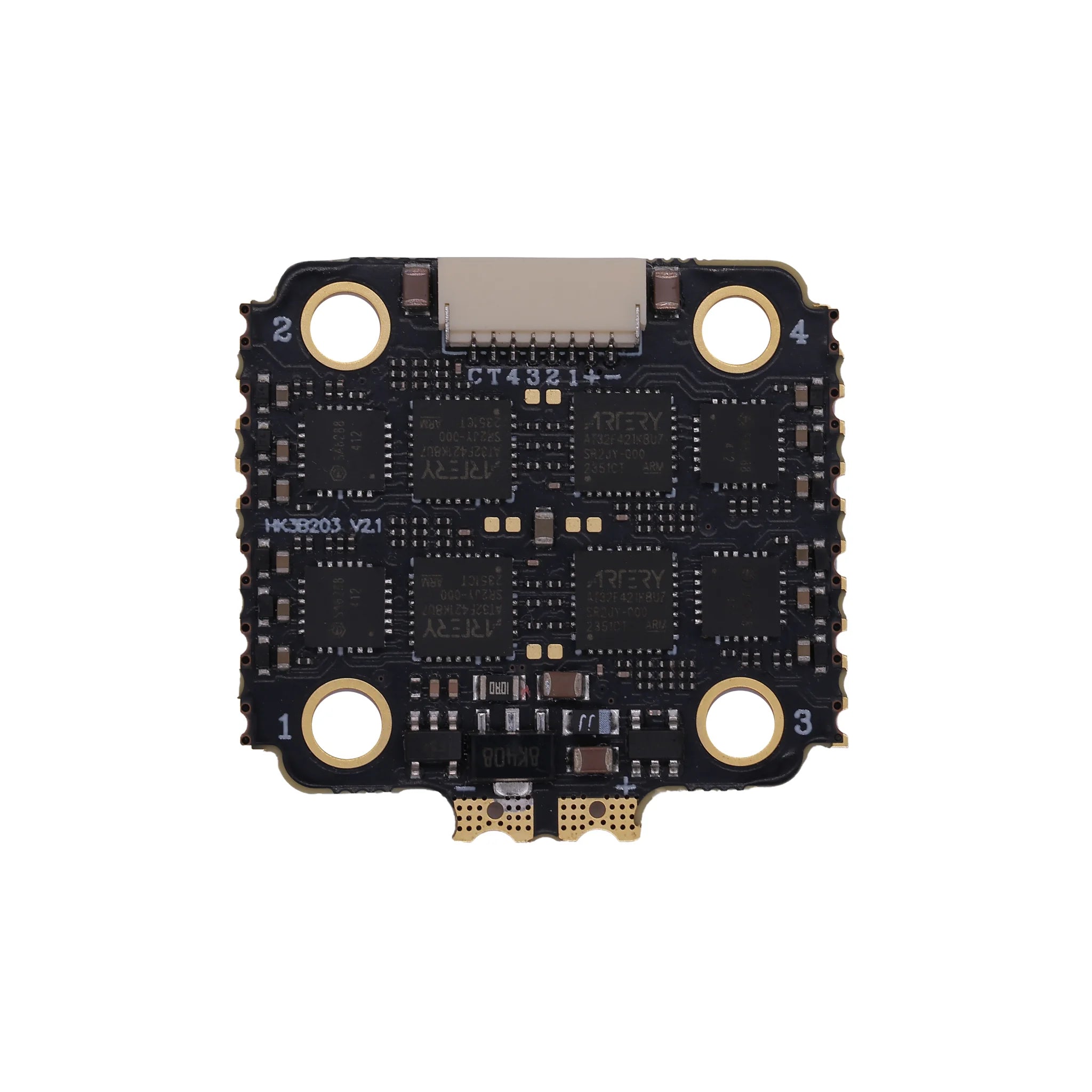What is an FPV Stack? A Beginner’s Guide
Imagine your FPV drone as a high-speed race car. The stack (or “fly tower”) is like the car’s brain and engine working together. It combines two key parts:
- Flight Controller (FC): The brain, processing your joystick commands, keeping the drone stable, and reading sensors like a gyroscope (which senses tilt and spin).
- Electronic Speed Controller (ESC): The engine, telling the motors how fast to spin based on your inputs.
Think of a stack like a smartphone: the FC is the processor (running apps smoothly), and the ESC is the battery (powering everything). Without a good stack, your drone might wobble, crash, or fail to do cool tricks like flips or rolls. A stack ensures your drone flies steady, responds quickly, and handles the power of your battery (like a 4S or 6S LiPo).
Why do you need a stack? It simplifies building your drone. Instead of buying separate FCs and ESCs, a stack is pre-designed to work together, saving you time and reducing messy wiring. It’s perfect for most FPV drones, from 3-inch Cinewhoops (for smooth video) to 5-inch freestyle beasts (for flips and dives).
At NZFPV, we’re an authorized distributor of HAKRC, a brand trusted for reliable, high-performance stacks. This guide will explain stacks in simple terms, help you pick the right one, and showcase our HAKRC lineup for every pilot.
Stack vs. AIO: Which is Right for You?
You might hear about AIO (All-in-One) boards and wonder how they compare to stacks. Here’s the difference:
- Stack: Two boards (FC and ESC) stacked together. It’s stronger, handles more power, and is easier to repair. Best for 3- to 7-inch drones used in freestyle, racing, or cinematic flying.
- AIO: Everything (FC, ESC, sometimes video transmitter) on one tiny board. Great for super-small drones (like 2-inch Tiny Whoops) but less durable for big, powerful builds.
For most FPV pilots, stacks are the way to go. They’re like a sturdy laptop you can upgrade, while AIOs are like a compact tablet for basic tasks.
How to Choose the Perfect FPV Stack
Picking a stack can feel overwhelming, but it’s like choosing a gaming console: match it to your needs. Here’s what to consider:
-
Drone Size:
- 30.5x30.5mm stacks: Fit 5-inch or larger drones for racing or freestyle.
- 20x20mm stacks: Ideal for 3- to 4-inch Cinewhoops or lightweight drones.
-
Flying Style:
- Freestyle: Needs a stack with strong ESCs (50A+) for flips and tricks.
- Racing: Prioritize fast processors (F7) for quick response.
- Cinematic: Lightweight stacks (35-40A) for smooth, stable flights.
-
Skill Level:
- Beginners: Start with F4 processors and 35-50A ESCs for simplicity.
- Advanced: Go for F7 processors and 60A+ ESCs for power and precision.
-
Battery Compatibility:
- Most stacks support 2-6S batteries; some handle 8S for extra power.
-
Extra Features:
- Programmable LEDs for cool lighting.
- Dual gyroscopes for smoother flights.
- Betaflight support for easy tuning.
Beginner FAQs
-
Do I need a power distribution board (PDB)?
No! HAKRC stacks have built-in power distribution, so you don’t need a separate PDB.
-
Can I upgrade my stack later?
Yes, stacks are modular. You can swap them out as your skills grow.
-
Why is my drone twitching?
This could be a loose connection or outdated firmware. Check wiring and update Betaflight.
Step-by-Step: Installing Your HAKRC Stack
Here’s a quick guide to get your stack up and running:
- Check Components: Ensure all accessories (screws, shock-absorbing balls, cables) are included.
- Mount the Stack: Use the provided nylon pillars and M2/M3 screws. Tighten gently with fingers to avoid damaging the board.
- Connect Wires: Follow the wiring diagram (included with HAKRC stacks). Double-check positive/negative polarity.
-
Configure Betaflight:
- Plug the stack into your computer via USB.
- Set up motor direction, receiver protocol (e.g., SBUS), and calibrate the gyroscope.
- Test Safely: Don’t install propellers until everything’s configured. Test motors in Betaflight first.
Tip: Always check for solder splashes on the stack to prevent short circuits.
NZFPV’s HAKRC Stack Lineup
NZFPV offers a full range of HAKRC stacks for every FPV pilot. Below, we detail each stack’s specs and who it’s best for, based on your drone and flying goals.
1. HAKRC 65A F4 V2 Fly Tower
- Specifications: STM32F405RGT6 processor, 65A 4-in-1 ESC, 30.5x30.5mm, 2-6S, ICM42688 gyroscope, five UART ports, programmable LEDs.
- Best For: Pilots flying 5-inch freestyle or racing drones who want power for flips, rolls, and high-speed runs. Perfect if you’re practicing in open fields and starting to push your skills with 6S batteries.

2. HAKRC 65A F7 V2 Fly Tower
- Specifications: STM32F722RET6 processor, 65A 4-in-1 ESC, 30.5x30.5mm, 2-6S, dual ICM42688 gyroscopes, six UART ports, programmable LEDs.
- Best For: Experienced racers or cinematic pilots flying 5- to 7-inch drones. Ideal for competitive racing on tight tracks or capturing smooth HD footage with heavy cameras.

3. HAKRC 60A Mini F7 V2 Fly Tower
- Specifications: STM32F722RET6 processor, 60A 4-in-1 ESC, 20x20mm, 2-8S, dual ICM42688 gyroscopes, five UART ports.
- Best For: Intermediate pilots building 3- to 4-inch Cinewhoops for cinematic shots or compact freestyle drones. Great if you’re filming in tight spaces and need 8S power for future upgrades.

4. HAKRC 60A Mini F4 V2 Fly Tower
- Specifications: STM32F405RGT6 processor, 60A 4-in-1 ESC, 20x20mm, 2-8S, ICM42688 gyroscope, five UART ports.
- Best For: New pilots building 3- to 4-inch drones for casual flying or light freestyle. Choose this if you’re learning in a park and want a budget-friendly stack with room to grow.

5. HAKRC 50A F7 V2 Fly Tower
- Specifications: STM32F722RET6 processor, 50A 4-in-1 ESC, 30.5x30.5mm, 2-6S, dual ICM42688 gyroscopes, five UART ports.
- Best For: Intermediate pilots flying 5-inch freestyle drones for smooth tricks in local fields. Ideal if you’re upgrading from a beginner stack and want better performance.

6. HAKRC 50A F4 V2 Fly Tower
- Specifications: STM32F405RGT6 processor, 50A 4-in-1 ESC, 20/30.5mm mounting, 2-6S, ICM42688 gyroscope, five UART ports.
- Best For: DIY pilots building 4- to 5-inch drones who need flexibility for different frames. Pick this if you’re experimenting with multiple drone sizes and want a reliable all-rounder.

7. HAKRC 40A Mini F7 V2 Fly Tower
- Specifications: STM32F722RET6 processor, 40A 4-in-1 ESC, 20x20mm, 2-6S, dual ICM42688 gyroscopes, six UART ports.
- Best For: Cinematic pilots flying 3-inch Cinewhoops for YouTube videos or indoor shoots. Great if you’re prioritizing smooth flights over raw power.

8. HAKRC 40A Mini F4 V2 Fly Tower
- Specifications: STM32F405RGT6 processor, 40A 4-in-1 ESC, 20x20mm, 2-6S, ICM42688 gyroscope, five UART ports.
- Best For: Absolute beginners flying 3-inch drones in backyards or parks. Choose this if you’re new to FPV and want an easy-to-use stack for learning.

9. HAKRC 35A Mini F7 V2 Fly Tower
- Specifications: STM32F722RET6 processor, 35A 4-in-1 ESC, 20x20mm, 2-6S, ICM42688 gyroscope, six UART ports.
- Best For: Pilots flying 2- to 3-inch micro drones for indoor fun or light cinematic shots. Ideal if you’re carrying a lightweight camera and need a tiny, efficient stack.

Product Comparison Table
| Model | Processor | ESC Rating | Mounting | Voltage | Best For |
|---|---|---|---|---|---|
| 65A F4 V2 | F4 | 65A | 30.5x30.5mm | 2-6S | 5-inch Freestyle/Racing |
| 65A F7 V2 | F7 | 65A | 30.5x30.5mm | 2-6S | 5-7-inch Racing/Cinematic |
| 60A Mini F7 V2 | F7 | 60A | 20x20mm | 2-8S | 3-4-inch Cinewhoops |
| 60A Mini F4 V2 | F4 | 60A | 20x20mm | 2-8S | 3-4-inch Beginner Builds |
| 50A F7 V2 | F7 | 50A | 30.5x30.5mm | 2-6S | 5-inch Freestyle |
| 50A F4 V2 | F4 | 50A | 20/30.5mm | 2-6S | 4-5-inch Versatile Builds |
| 40A Mini F7 V2 | F7 | 40A | 20x20mm | 2-6S | 3-inch Cinewhoops |
| 40A Mini F4 V2 | F4 | 40A | 20x20mm | 2-6S | 3-inch Beginner Drones |
| 35A Mini F7 V2 | F7 | 35A | 20x20mm | 2-6S | 2-3-inch Micro Drones |
Stack Selection Flowchart
Answer these questions to find your stack:
-
What’s your drone size?
- 5-inch or larger → Choose 30.5x30.5mm stacks (e.g., 65A F4/F7).
- 3-4-inch → Choose 20x20mm stacks (e.g., 60A Mini F7).
- 2-3-inch → Choose lightweight 20x20mm stacks (e.g., 35A Mini F7).
-
What’s your flying style?
- Freestyle/Racing → High-current stacks (50A+).
- Cinematic → Lightweight stacks (35-40A).
- Learning → Budget-friendly F4 stacks.
-
What’s your skill level?
- Beginner → F4 for simplicity.
- Intermediate/Advanced → F7 for speed and features.
Maintenance Tips for Your HAKRC Stack
- Check for Damage: Inspect for solder splashes or loose wires before powering on.
- Update Firmware: Use Betaflight to keep your stack running the latest software.
- Clean Regularly: Remove dust or debris to prevent overheating.
- Store Safely: Keep your drone in a dry, cool place to protect the stack.
Why Choose NZFPV for HAKRC Stacks?
As a manufacturer and authorized HAKRC distributor, NZFPV offers:
- Wide Selection: Stacks for every drone and pilot, from micro to pro-grade.
- Fast U.S. Shipping: Get your order in days, not weeks.
- Expert Support: Our team helps with setup, troubleshooting, and more.
- HAKRC Quality: Rigorously tested components for reliable flights.
Start Building Today!
Ready to soar with a HAKRC stack? Visit NZFPV to explore our full range of FPV components. From beginners to pros, we’ve got the stack to make your drone shine. Questions? Email us at info@nzfpv.com for expert advice.





